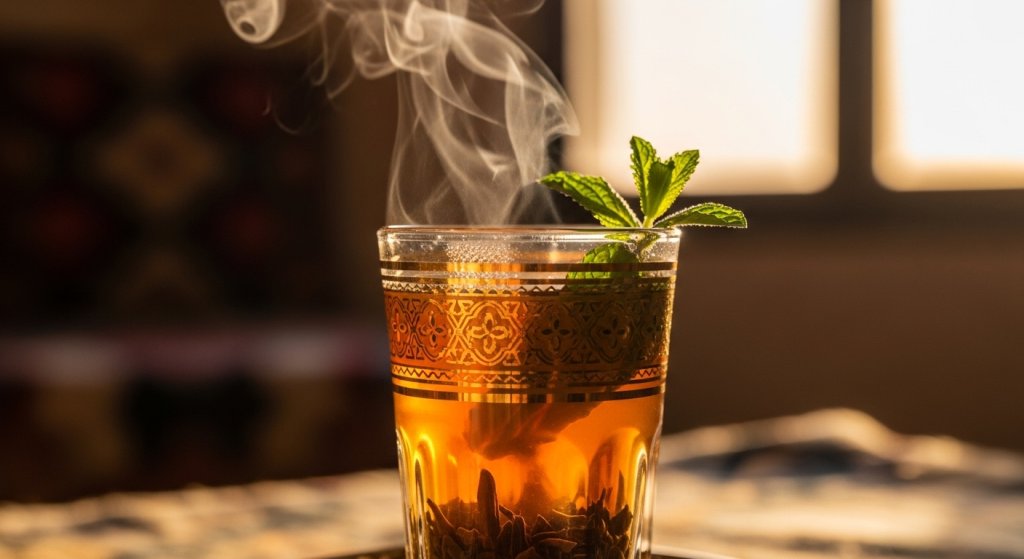When you think of arab tea, you might imagine a cup of hot, sweet brew. But arabic tea is more than just a drink; it’s a symbol of hospitality, culture, and social connection. The act of sharing arab tea is a powerful tradition across the Middle East. People offer it to guests as a sign of welcome, and it is a key part of conversations, celebrations, and daily life. Understanding its history and different varieties is a great way to deepen your knowledge of the Arabic language and culture.
History of Arabic Tea
The history of Arabic tea began far away, in ancient China. Arab merchants traveling along the Silk Road brought tea back to their homelands thousands of years ago. At first, people used it as a rare and valuable item for its medicinal properties. Over time, however, tea became popular and developed from a simple beverage into an essential part of the regional way of life. Today, it is a key part of hospitality and daily life. People serve it with breakfast, after lunch, and with dinner. In Arab society, people often consider it impolite to reject tea when someone offers it.
Tea in Arabic and How to Order It
The word for tea in arabic is shay (شاي). Knowing this word and a few simple phrases can help you order and enjoy tea like a local.
- Tea: Shay (شاي)
- A cup of tea: Finjān shay (فنجان شاي)
- A teapot: Ibrīq (إبريق)
- With sugar: Bi-sukkar (بسكر)
- Without sugar: Bidun sukkar (بدون سكر)
- With mint: Bi-na’na’ (بنعناع)
When someone offers you a cup of tea, it is a sign of hospitality. People often consider it rude to refuse it. This is true whether you are in a home, a café, or even in a business meeting.
Types of Arab Teas
There is a wide variety of types of arab teas, each with its own special flavor and purpose. Here are some of the most common varieties of tea you can find.
Black and Green Tea Varieties
- Black Tea: This is the most common type of arab tea. People often serve it strong and sweet, sometimes with milk, and it is a staple in most households. In Egypt, people sometimes call it shay Koshary (شاي كشري) when they brew it very strong.
- Maghrebi Mint Tea: This is a green tea people prepare with spearmint leaves and a lot of sugar. It is especially famous in the Maghreb region (Morocco, Algeria, Tunisia). People brew and pour the tea in a specific ritual, often from a height, to create a foam on top.
Popular Herbal Teas
- Hibiscus Tea: Known as karkadeh (كركديه), this tea comes from dried hibiscus flowers. People drink it hot in the winter and cold in the summer. It is also known for its high vitamin C content and a distinct, tangy flavor.
- Sage Tea: Known as maramiyyah (ميرمية), this herbal tea is popular, especially after meals. People think it helps with digestion and has a calming effect.
- Anise Tea: This tea comes from anise seeds and has a sweet, licorice-like flavor. People often serve it to help with stomach problems.
- Thyme Tea: Known as zaatar tea (شاي زعتر), this herbal tea comes from dried thyme leaves. It is a popular drink in the Levant, and people often believe it improves memory and digestion.
Unique Regional Teas
- Cardamom Tea: This tea has a strong aroma. People often brew it with black tea and cardamom pods. It is a very common type of tea in the Arab world, especially in the Gulf region, where they often serve it with coffee.
- Dried Lime Tea: Known as chai noomi basra (شاي نومي بصرة), this herbal tea comes from dried limes. It is a traditional tea in Iraq and the Gulf countries and has a very sour, refreshing taste.
- Cinnamon Tea: This tea, made with cinnamon sticks and sugar, is especially popular in Kuwait and other Gulf countries. It is known for its sweet and spicy flavor, and people often call it “Kuwaiti tea.”
A Note on Egyptian Arabic
If you want to learn egyptian arabic, you’ll find that tea culture is very important there. In Egypt, people often serve tea in a small glass cup and it is usually black and very sweet. A common way to order tea is to say shay (tea). The simple word shay (شاي) and the phrases above will work perfectly there, just as they do in many other Arabic-speaking countries.
Conclusion
Arab tea is a drink with a rich history and a deep cultural meaning. From the strong black tea of Egypt to the sweet mint tea of Morocco, each cup tells a story. By learning the vocabulary and traditions of arabic tea, you are not only learning a language but also participating in a timeless tradition of hospitality and friendship.
To continue your journey into the richness of the Arabic language and its cultures, consider using the Kaleela app. It provides comprehensive lessons on Modern Standard Arabic and various dialects, helping you master not just the words but also the traditions behind them.



